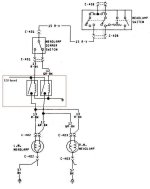Banjer Picker
Bronco Guru
- Joined
- Sep 25, 2006
- Messages
- 1,357
1st question(s): Do the headlight and dimmer switches operate under 12 volts on a factory wiring harness? Are there any fuses between positive batter terminal and the light switch?
Next area:
*I've read numerous articles on upgrading headlights with two 12v 30 amp relays, but each one I read, tells you a completely different configuration (schematic) to wire the 4 posts (30, 87, 85 & 86). I know what the inside of the relays look like and the mechanics behind what makes them work, so I don't understand how you can wire them 6 different ways and still get the same end effect? Which is THE RIGHT way?
*With the the relay upgrades: If I have to run a 20 amp fuse between the positive battery terminal and relay, why dont I have to run a fuse between the positve battery terminal and the light switch?
*Getting frustrated. :-X Any insight is VERY appreciated.
Next area:
*I've read numerous articles on upgrading headlights with two 12v 30 amp relays, but each one I read, tells you a completely different configuration (schematic) to wire the 4 posts (30, 87, 85 & 86). I know what the inside of the relays look like and the mechanics behind what makes them work, so I don't understand how you can wire them 6 different ways and still get the same end effect? Which is THE RIGHT way?
*With the the relay upgrades: If I have to run a 20 amp fuse between the positive battery terminal and relay, why dont I have to run a fuse between the positve battery terminal and the light switch?
*Getting frustrated. :-X Any insight is VERY appreciated.











